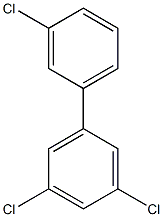Chemical Properties
Viscous, oily, light yellow to pale yellow-brown liquid or white powder with a weak,
characteristic odor
Uses
Insulator fluid for electric condensers; additive in high pressure lubricants. In fluorescent
and high-intensity discharge ballasts manufactured prior to 1979 (U.S. EPA, 1998).
At a concentration of 5 to 25 wt %, increased the effective kill-life of the lindane spray up to 10
times. May have been used in chlordane and BHC insecticide formulations (Monsanto, 1960).
Environmental Fate
Biological. Reported degradation products by the microorganism Alcaligenes BM-2 for a
mixture of polychlorinated biphenyls include monohydroxychlorobiphenyl, 2-hydroxy-6-
oxochlorophenylhexa-2,4-dieonic acid, chlorobenzoic acid, chlorobenzoylpropionic acid,
chlorophenylacetic acid, and 3-chlorophenyl-2-chloropropenic acid (Yagi and Sudo, 1980). When
PCB-1016 was statically incubated in the dark at 25 °C with yeast extract and settled domestic
wastewater inoculum, no significant biodegradation was observed. At a concentration of 5 mg/L,
percent losses after 7, 14, 21, and 28-d incubation periods were 44, 47, 46, and 48, respectively. At
a concentration of 10 mg/L, only 22, 46, 20, and 13% losses were observed after the 7, 14, 21, and
28-d incubation periods, respectively (Tabak et al., 1981).
Chemical/Physical. PCB-1016 will not hydrolyze to any reasonable extent (Kollig, 1993).





